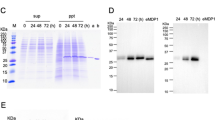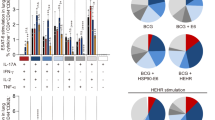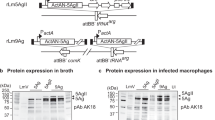Abstract
There are 3 million deaths per annum worldwide due to tuberculosis, and AIDS is compounding the problem. A better vaccine than the live mycobacterium currently in use, bacillus Calmette–Guérin (BCG), is needed. When mice were injected with plasmid DNA encoding a single mycobacterial antigen (65–kDa heat shock protein, hsp65) they made specific cellular and humoral responses to the protein and became immune to subsequent challenge with Mycobacterium tuberculosis. Protection was equivalent to that obtained by vaccinating with live BCG, whereas immunizing with the protein was ineffective. Protection was also obtained with DNA encoding another mycobacterial antigen (36–kDa proline–rich antigen). These results suggest that DNA vaccination might yield improved vaccines to replace BCG.
This is a preview of subscription content, access via your institution
Access options
Subscribe to this journal
Receive 12 print issues and online access
$209.00 per year
only $17.42 per issue
Buy this article
- Purchase on Springer Link
- Instant access to full article PDF
Prices may be subject to local taxes which are calculated during checkout
Similar content being viewed by others
References
Yewdell, J.W. & Bennink, J.R. Cell biology of antigen processing and presentation to major histocompatibility complex class I molecule-restricted T lymphocytes. Adv. Immunol. 52, 1–123 (1992).
Silva, C.L. & Lowrie, D.B. A single mycobacterial protein (hsp 65) expressed by a transgenic antigen-presenting cell vaccinates mice against tuberculosis. Immunology 82, 244–248 (1994).
Silva, C.L., Silva, M.F., Pietro, R.C.L.R. & Lowrie, D.B. Characterization of T cells that confer a high degree of protective immunity against tuberculosis in mice after vaccination with tumor cells expressing mycobacterial hsp65. Infect. Immun. 64, 2400–2407 (1996).
Gautier, G., Mehtali, M. & Lathe, R. A ubiquitous mammalian expression vector, pHMG, based on a housekeeping gene promoter. Nucleic Acids Res. 17, 8389 (1989).
Zhu, N., Liggitt, D., Liu, Y. & Debs, R. Systemic gene expression after intravenous DNA delivery into adult mice. Science 261, 209–211 (1993).
Thole, J.E.R. et al. A major immunogenic 36,000-molecular weight antigen from Mycobacterium leprae contains an immunoreactive region of proline-rich repeats. Infect. Immun. 58, 80–87 (1990).
Flynn, J.L. et al. An essential role for interferon-γ in resistance to Mycobacterium tuberculosis infection. J. Exp. Med. 178, 2249–2254 (1993).
DeLibero, G., Flesch, I. & Kaufmann, S.H.E., Mycobacteria-reactive Lyt-2+ T cell lines. Eur. J. Immunol. 18, 59–66 (1988).
Orme, I.M. The role of CD8+ T cells in immunity to tuberculosis infection. Trends Microbiol. 1, 77–78 (1993).
Muller, I., Cobbold, S., Waldmann, H. & Kauffman, S.H.E. Impaired resistance to Mycobacterium tuberculosis infection after selective in vivo depletion of L3T4+ and Lyt-2+ T cells. Infect. Immun. 55, 2037 (1987).
Jones, R.F. & Wei, W.-Z. PEPMOTIF: A program for locating class I major histocompatibility complex restricted peptides in protein sequences. J. Immunol. Methods 179, 137–138 (1995).
Wiltrout, R.H., Brunder, M.J. & Holden, H.T. Variation in selectivity of tumor cell lysis by murine macrophages, macrophage-like cell lines and NK cells. Int. J. Cancer 30, 335–342 (1982).
Koga, T. et al. T cells against a bacterial heat shock protein recognize stressed macrophages. Science 245, 1112–1115 (1989).
Cox, J.M., Zamb, T.J. & Babiuk, L.A. Bovine herpes virusl: Immune responses in mice and cattle injected with plasmid DNA. J. Virol. 67, 5664–5667 (1993).
Xiang, Z.Q. et al. Vaccination with a plasmid vector carrying the rabies virus glycoprotein gene induces protective immunity against rabies virus. Virology 199, 132–140 (1994).
Sedegah, M., Hedstrom, R., Hobart, P. & Hoffman, S.L. Protection against malaria by immunization with plasmid DNA encoding circumsporozoite protein. Proc. Natl. Acad. Sci. USA 91, 9866–9870 (1994).
Xu, D. & Liew, F.Y. Genetic vaccination against leishmaniasis. Vaccine 12, 1534–1536 (1994).
Donnelly, J.J. et al. Preclinical efficacy of a prototype DNA vaccine: Enhanced protection against antigenic drift in influenza virus. Nature Med. 1, 583–587 (1995).
Fynan, E.F. et al. DNA vaccines: A novel approach to immunization. Int. J. Immunopharmac. 17, 79–83 (1995).
Bothamley, G.H., Festenstein, F. & Newland, A. Protective role for CDS cells in tuberculosis. Lancet 339, 315–316 (1992).
Ottenhoff, T.H.M. & Mutis, T. Role of cytotoxic cells in the protective immunity against and immunopathology of intracellular infections. Eur. J. Clin. Invest. 25, 371–377 (1995).
Molloy, A., Laochumroonvorapong, P. & Kaplan, G., Apoptosis, but not necrosis, of infected monocytes is coupled with killing of intracellular bacillus Calmette-Guérin. J. Exp. Med. 180, 1499–1509 (1994).
Blanchard, D.K. et al. Role of extracellular adenosine triphosphate in the cytotoxic T-lymphocyte-mediated lysis of antigen presenting cells. Blood 85, 3173–3182 (1995).
Thole, J.E.R. & van der Zee, R. The 65 kD antigen: Molecular studies on a ubiquitous antigen. in Molecular Biology of the Mycobacteria (ed. McFadden, J.) 37–67 (Academic Press, London, UK, 1990).
Young, D.B., Garbe, T., Lathigra, R. & Abu-Zeid, C. Protein antigens: Structure, function and regulation. in Molecular Biology of the Mycobacteria (ed. McFadden, J.) 1–35 (Academic Press, London, UK, 1990).
Andersen, P. Effective vaccination of mice against Mycobacterium tuberculosis infection with a soluble mixture of secreted mycobacterial proteins. Infect. Immun. 62, 2536–2544 (1994).
Robertson, J.S. Safety considerations for nucleic acid vaccines. Vaccine 12, 1526–1528 (1994).
Elias, D., Markovits, D., Reshef, T., van der Zee, R. & Cohen, I.R. Induction and therapy of autoimmune diabetes in the non-obese diabetic (NOD/Lt) mouse by a 65-kDa heat shock protein. Proc. Natl. Acad. Sci. USA 87, 1576–1580 (1990).
Billingham, M.E.J., Carney, S., Butler, R. & Colston, M.J. A mycobacterial 65-kD heat shock protein induces antigen-specific suppression of adjuvant arthritis, but is not itself arthritogenic. J. Exp. Med. 171, 339–344 (1990).
Xu, Q. et al. Association of serum antibodies to heat-shock protein 65 with carotid atherosclerosis. Lancet 341, 255–259 (1993).
Yang, N.-S. Gene transfer into mammalian somatic cells. Crit. Rev. Biotechnol. 12, 335–356 (1992).
Jiao, S. et al. Direct gene transfer into nonhuman primate myofibers in vivo . Hum. Gene Ther. 3, 21–33 (1992).
Wolff, J.A., Ludtke, J.J., Acsadi, G., Williams, P. & Jani, A. Long-term persistence of plasmid DNA and foreign gene expression in mouse muscle. Hum. Mol. Genet. 1, 363–369 (1992).
Mehra, V., Sweetser, D. & Young, R.A. Efficient mapping of protein antigenic determinants. Proc. Natl. Acad. Sci. USA 83, 7013–7017 (1986).
Walker, K.B., Butler, B. & Colston, M.J. Role of Th-1 lymphocytes in the development of protective immunity against M. leprae . J. Immunol. 184, 1885–1889 (1992).
Southern, E.M. Detection of specific sequences among DNA fragments separated by gel electrophoresis. J. Mol. Biol. 98, 503–517 (1975).
Towbin, H., Staenelin, T. & Gordon, J. Electrophoretic transfer of proteins from polyacrylamide gels to nitro cellulose sheets: Procedure and some applications. Proc. Natl. Acad. Sci. USA 76, 4350–4354 (1979).
Anderson, D.C., Barry, M.E. & Buchanan, T.M. Exact definition of species-specific and cross-reactive epitopes of the 65-kilodalton protein of Mycobacterium leprae using synthetic peptides. J. Immunol. 141, 607–613 (1988).
Author information
Authors and Affiliations
Rights and permissions
About this article
Cite this article
Tascon, R., Colston, M., Ragno, S. et al. Vaccination against tuberculosis by DNA injection. Nat Med 2, 888–892 (1996). https://doi.org/10.1038/nm0896-888
Received:
Accepted:
Issue Date:
DOI: https://doi.org/10.1038/nm0896-888
This article is cited by
-
Identification of antigens presented by MHC for vaccines against tuberculosis
npj Vaccines (2020)
-
Serum biomarkers of Burkholderia mallei infection elucidated by proteomic imaging of skin and lung abscesses
Clinical Proteomics (2015)
-
Adjunctive immunotherapy with α-crystallin based DNA vaccination reduces Tuberculosis chemotherapy period in chronically infected mice
Scientific Reports (2013)
-
Immunotherapeutic role of Ag85B as an adjunct to antituberculous chemotherapy
Journal of Immune Based Therapies and Vaccines (2011)
-
Intranasal vaccination with messenger RNA as a new approach in gene therapy: Use against tuberculosis
BMC Biotechnology (2010)



